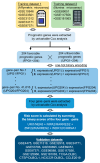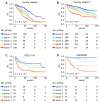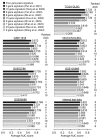Development and Validation of a Novel Four Gene-Pairs Signature for Predicting Prognosis in DLBCL Patients
- PMID: 39684518
- PMCID: PMC11640839
- DOI: 10.3390/ijms252312807
Development and Validation of a Novel Four Gene-Pairs Signature for Predicting Prognosis in DLBCL Patients
Abstract
Diffuse large B-cell lymphoma (DLBCL) is the most common subtype of non-Hodgkin's lymphoma. Because individual clinical outcomes of DLBCL in response to standard therapy differ widely, new treatment strategies are being investigated to improve therapeutic efficacy. In this study, we identified a novel signature for stratification of DLBCL useful for prognosis prediction and treatment selection. First, 408 prognostic gene sets were selected from approximately 2500 DLBCL samples in public databases, from which four gene-pair signatures consisting of seven prognostic genes were identified by Cox regression analysis. Then, the risk score was calculated based on these gene-pairs and we validated the risk score as a prognostic predictor for DLBCL patient outcomes. This risk score demonstrated independent predictive performance even when combined with other clinical parameters and molecular subtypes. Evaluating external DLBCL cohorts, we demonstrated that the risk-scoring model based the four gene-pair signatures leads to stable predictive performance, compared with nine existing predictive models. Finally, high-risk DLBCL showed high resistance to DNA damage caused by anticancer drugs, suggesting that this characteristic is responsible for the unfavorable prognosis of high-risk DLBCL patients. These results provide a novel index for classifying the biological characteristics of DLBCL and clearly indicate the importance of genetic analyses in the treatment of DLBCL.
Keywords: diffuse large B-cell lymphoma; drug sensitivity; gene signature; prognosis; public database.
Conflict of interest statement
A.T. belongs to the Laboratory of Highly-Advanced Veterinary Medical Technology, an endowment course, supported by Malignant Tumor Treatment Technologies, Inc. and receives a salary. J.N. is an employee of Malignant Tumor Treatment Technologies, Inc. and receives a salary. No disclosures were reported by H.S.
Figures







Similar articles
-
Lipid metabolism-related gene signature predicts prognosis and unveils novel anti-tumor drugs in specific type of diffuse large B cell lymphoma.Mol Med. 2024 Nov 13;30(1):210. doi: 10.1186/s10020-024-00988-4. Mol Med. 2024. PMID: 39538125 Free PMC article.
-
Discovery and validation of immune-associated long non-coding RNA biomarkers associated with clinically molecular subtype and prognosis in diffuse large B cell lymphoma.Mol Cancer. 2017 Jan 19;16(1):16. doi: 10.1186/s12943-017-0580-4. Mol Cancer. 2017. PMID: 28103885 Free PMC article.
-
SNRPB and CEP290, predicting the prognosis of diffuse large B cell lymphoma and associated with tumour immune microenvironment.Ann Med. 2024 Dec;56(1):2425065. doi: 10.1080/07853890.2024.2425065. Epub 2024 Dec 3. Ann Med. 2024. PMID: 39624962 Free PMC article.
-
The significance of FOXP1 in diffuse large B-cell lymphoma.Leuk Lymphoma. 2017 May;58(5):1037-1051. doi: 10.1080/10428194.2016.1228932. Epub 2016 Sep 27. Leuk Lymphoma. 2017. PMID: 27678023 Review.
-
Diffuse large B-cell lymphoma.Pathology. 2018 Jan;50(1):74-87. doi: 10.1016/j.pathol.2017.09.006. Epub 2017 Nov 20. Pathology. 2018. PMID: 29167021 Review.
Cited by
-
Genetic Subtype-Based International Prognostic Index Prognostic Model in Diffuse Large B-Cell Lymphoma.MedComm (2020). 2025 Jun 16;6(7):e70190. doi: 10.1002/mco2.70190. eCollection 2025 Jul. MedComm (2020). 2025. PMID: 40529616 Free PMC article.
References
-
- Maurer M.J., Ghesquières H., Jais J.P., Witzig T.E., Haioun C., Thompson C.A., Delarue R., Micallef I.N., Peyrade F., Macon W.R., et al. Event-free survival at 24 months is a robust end point for disease-related outcome in diffuse large B-cell lymphoma treated with immunochemotherapy. J. Clin. Oncol. 2014;32:1066–1073. doi: 10.1200/JCO.2013.51.5866. - DOI - PMC - PubMed
-
- Jelicic J., Juul-Jensen K., Bukumiric Z., Roost Clausen M., Ludvigsen Al-Mashhadi A., Pedersen R.S., Poulsen C.B., Brown P., El-Galaly T.C., Stauffer Larsen T. Prognostic indices in diffuse large B-cell lymphoma: A population-based comparison and validation study of multiple models. Blood Cancer J. 2023;13:1–12. doi: 10.1038/s41408-023-00930-7. - DOI - PMC - PubMed
Publication types
MeSH terms
Substances
LinkOut - more resources
Full Text Sources

